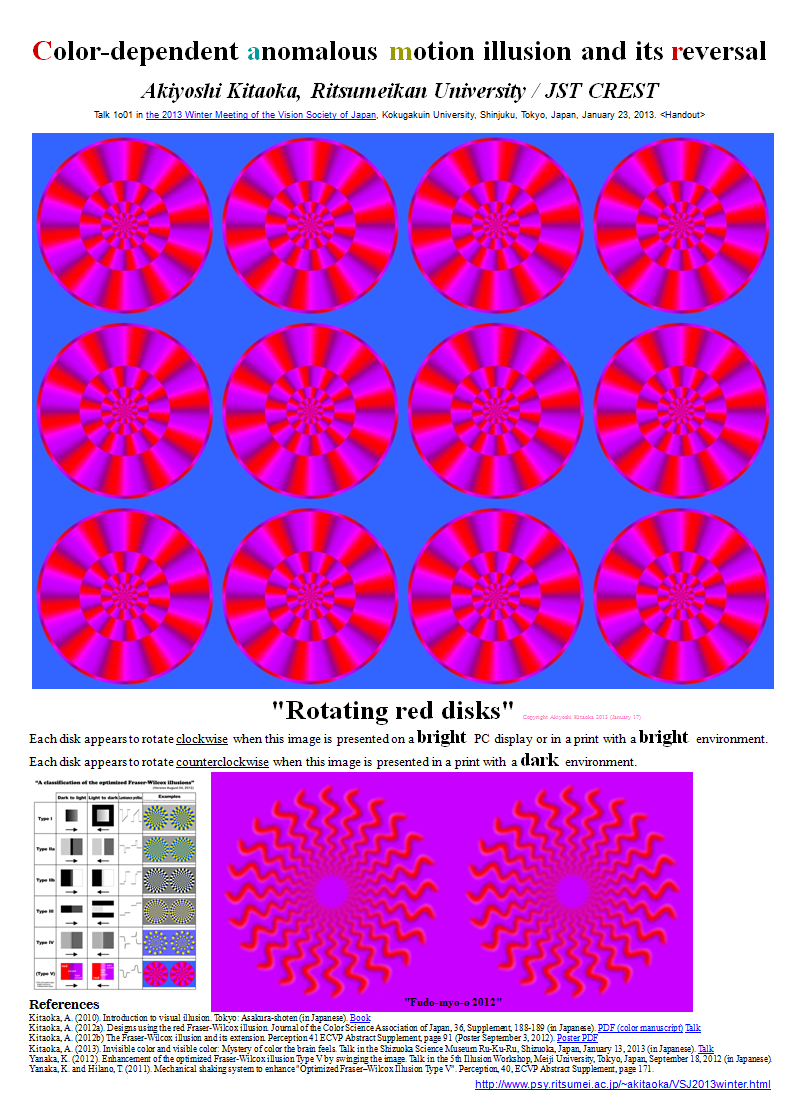Talk 1o01 in the 2013 Winter Meeting of the Vision Society of Japan
Kogakuin University, Shinjuku, Tokyo, Japan
January 23, 2013
Color-dependent anomalous motion illusion and its reversal
<色依存の静止画が動いて見える錯視と逆錯視>
Akiyoshi Kitaoka, Ritsumeikan University / JST CREST
since January 17, 2013 Handout
Warning: This page includes real animations. Please do not keep watching them for a long time. Although this page has carefully avoided the known harmful stimuli, unknown ones might happen to be included. Never copy them.
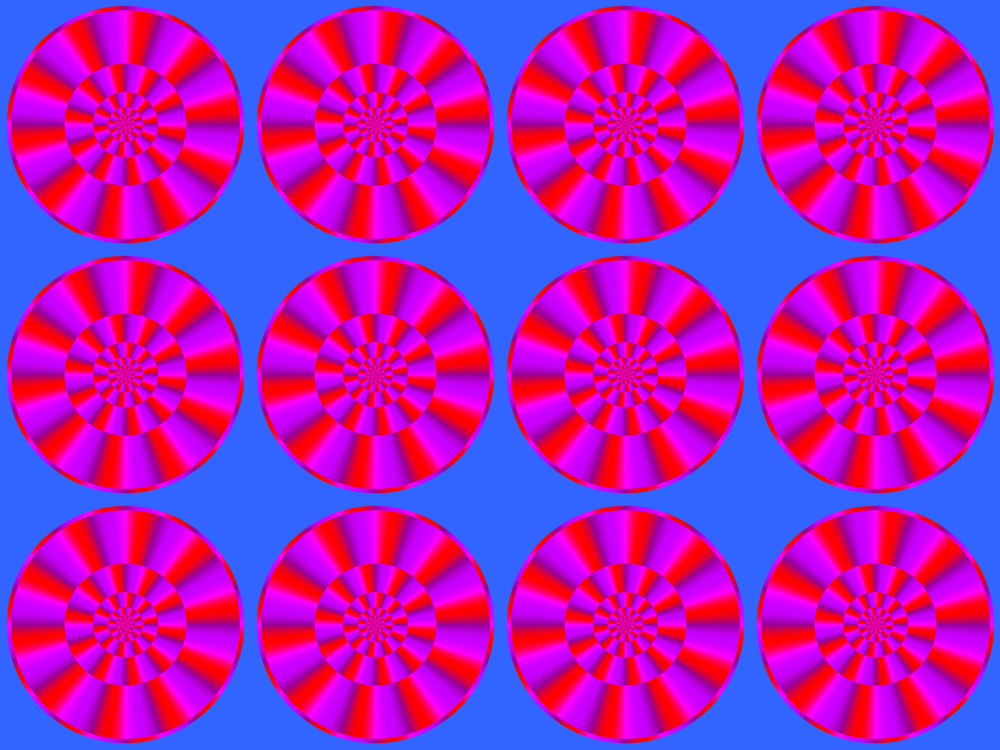
"Rotating red
disks"
Each disk appears to rotate clockwise when this image is presented on a bright PC display or in a print with a bright environment.
Copyright Akiyoshi Kitaoka 2013 (January 17)
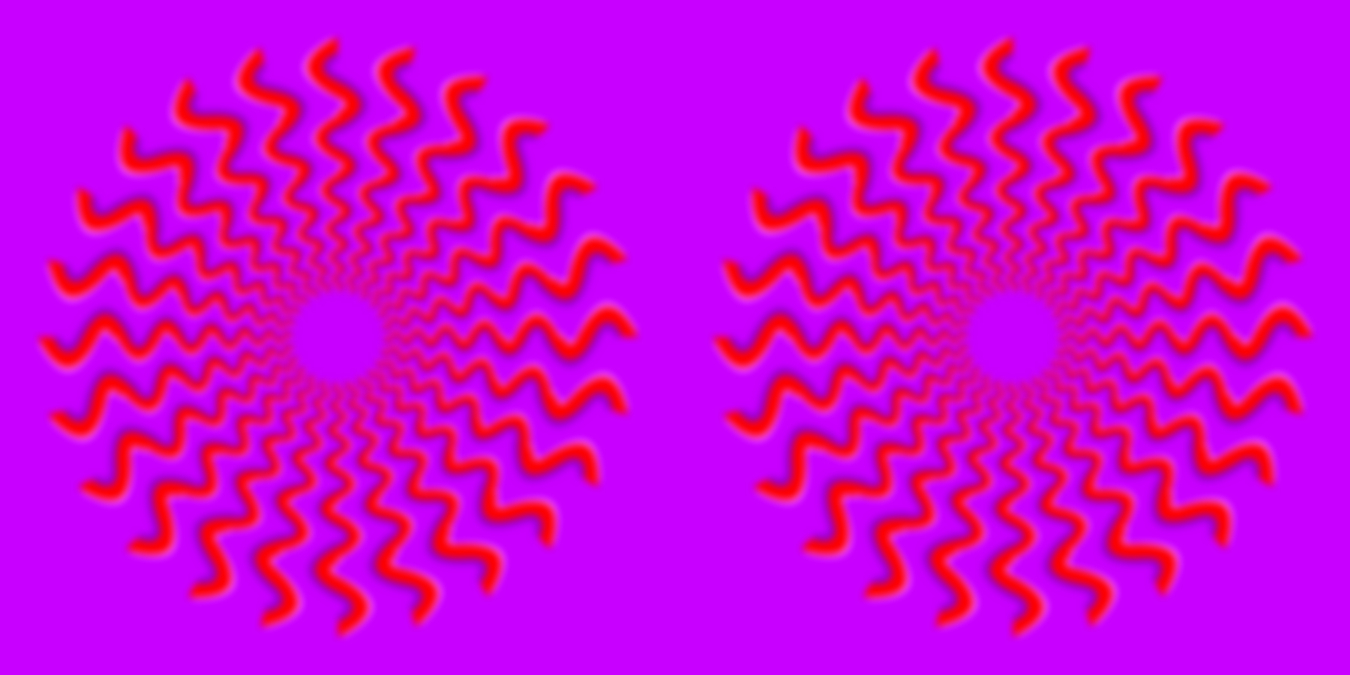
"Fudo-myo-o 2012"
Each disk appears to rotate clockwise when this image is presented on a bright PC display or in a print with a bright environment.
Copyright Akiyoshi Kitaoka 2012 (December 3)
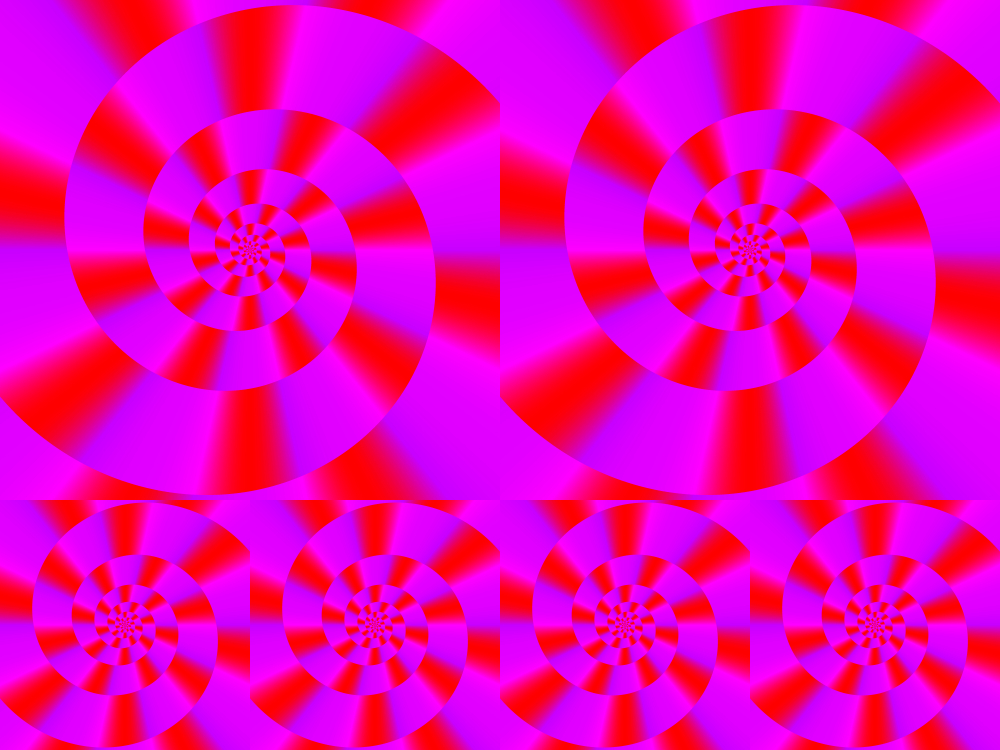
"Takonyudo"
takonyudo = octopus
Each disk appears to rotate counterclockwise when this image is presented on a bright PC display or in a print with a bright environment.
Copyright Akiyoshi Kitaoka 2009 (January 11)
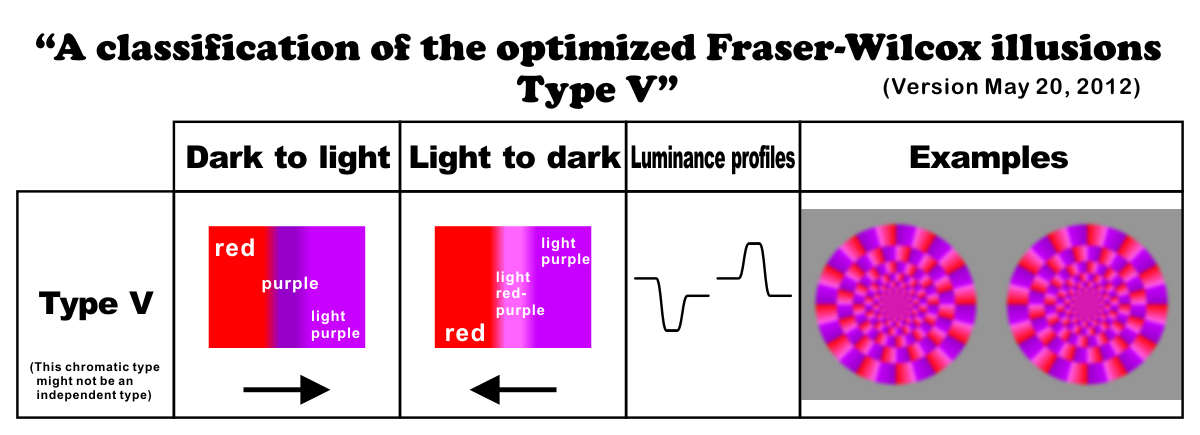
Copyright Akiyoshi Kitaoka 2012 (May 20)
"Rotating red
disks"
Each disk appears to rotate counterclockwise when this image is presented in a printed image with a dark environment.
Copyright Akiyoshi Kitaoka 2013 (January 17)
References
Yanaka, K. (2012). Enhancement of the optimized Fraser-Wilcox illusion Type V by swinging the image. Talk in the 5th Illusion Workshop, Meiji University, Tokyo, Japan, September 18, 2012.
Kitaoka, A. (2013). Invisible color and visible color: Mystery of color the brain feels. Talk in the Shizuoka Science Museum Ru-Ku-Ru, Shizuoka, Japan, January 13, 2013. Talk
A brief history of phenomenal aspects of the Fraser-Wilcox illusion group
<Kitaoka, A. (forthcoming). The Fraser-Wilcox illusion and its extension. In Shapiro, A. and Todorovic, D. (Eds.), Oxford Compendium of Visual Illusions. Oxford University Press.>
1. Fraser and Wilcox (1979)
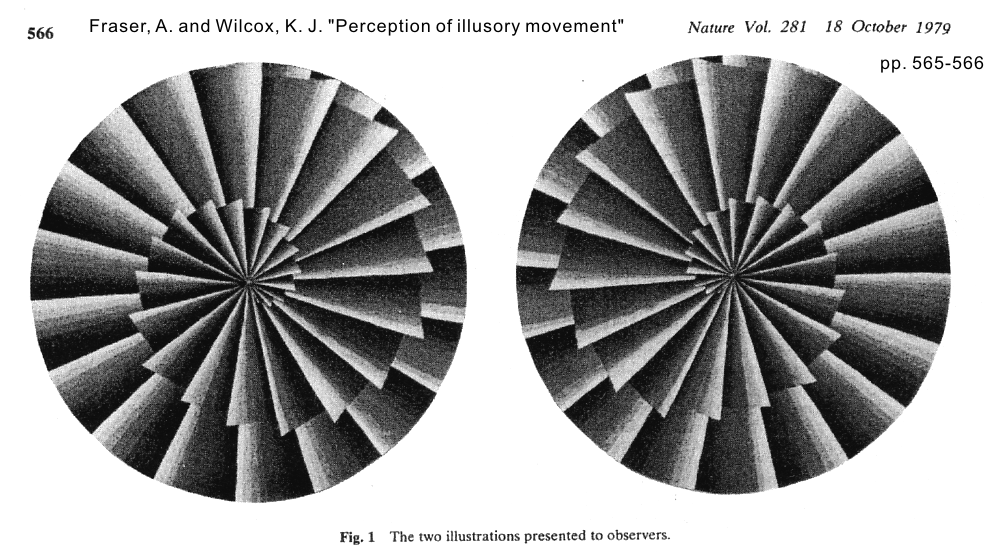
References
Fraser, A. and Wilcox, K. J. (1979). Perception of illusory movement. Nature, 281, 565-566.
Observers saw illusory motion in a stationary image which consists of repeated luminnace gradient in a saw-tooth wave form. Some reported illusory motion from dark to light along a luminance gradient, while others saw the reversal. The illusion is strong in the peripheral viewing. Fraser and Wilcox (1979) claimed that this individual difference depends on some genetic properties.
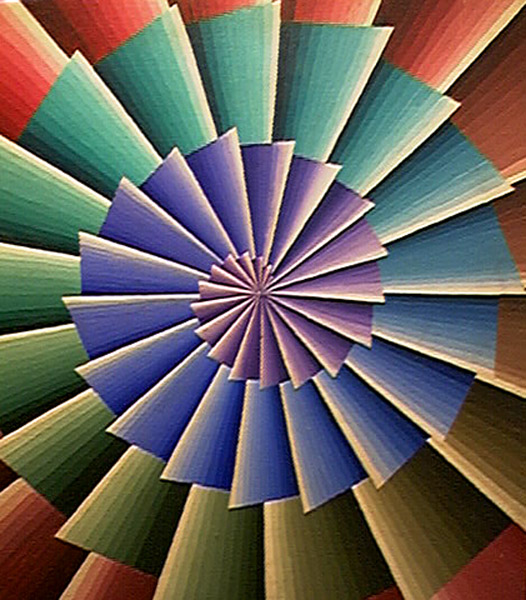
Adopted from “Alex Fraser, Geneticist and Painter”
(http://doctoralexfraser.blogspot.jp/p/spirals.html) <access August 25, 2012> (with permission from Alan Fraser)
Alex Fraser (1923-2002) was a geneticist and a painter.
2. Faubert and Herbert (1999)
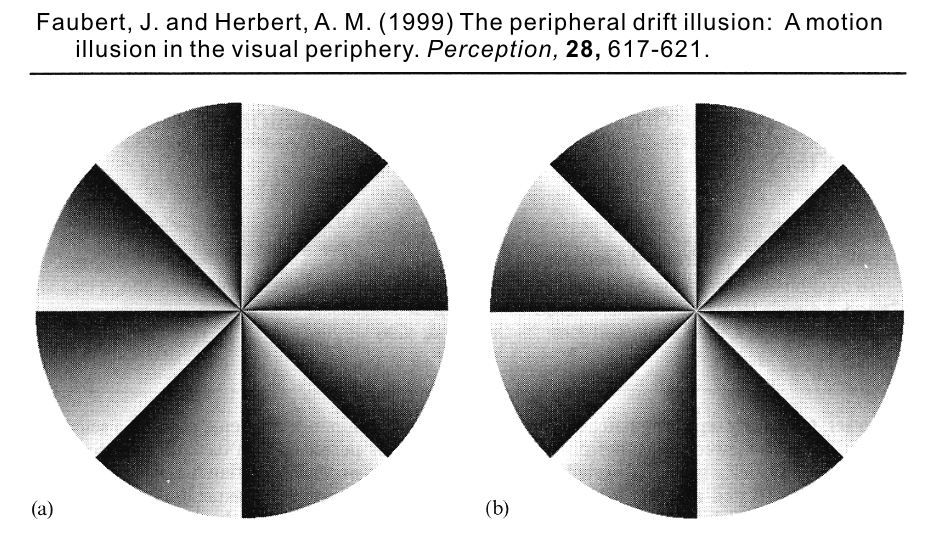
The left disk appears to rotate clockwise while the right one counterclockwise. Faubert and Herbert (1999) reported only illusory motion from dark to light along a luminance gradient. They attributed the illusory motion to the assumed time difference between responses to black and white.
References
Faubert, J. and Herbert, A. M. (1999). The peripheral drift illusion: A motion illusion in the visual periphery. Perception, 28, 617-621.
3. Naor-Raz and Sekuler (2000)
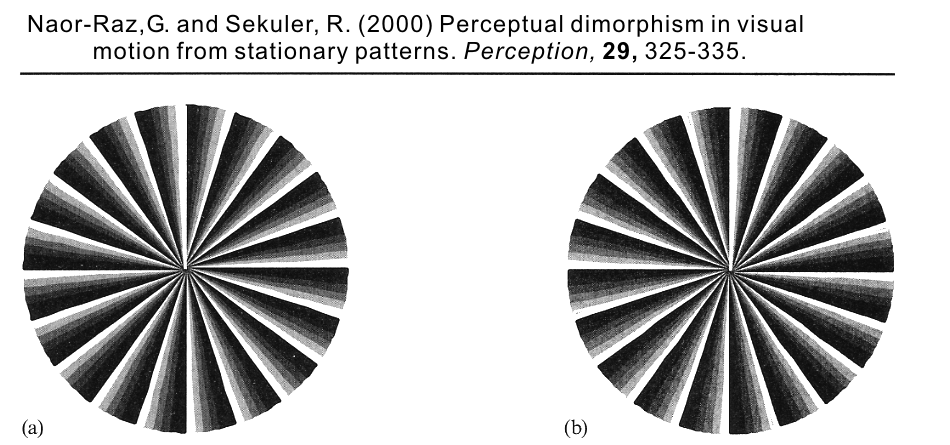
The left disk appears to rotate clockwise while the right one counterclockwise. Naor-Raz and Sekuler (2000), too, reported only illusory motion from dark to light along a luminance gradient. They revealed that the illusion magnitude is a positive, nearly linear function of contrast.
References
Naor-Raz, G. and Sekuler, R. (2000). Perceptual dimorphism in visual motion from stationary patterns. Perception, 29, 325-335.
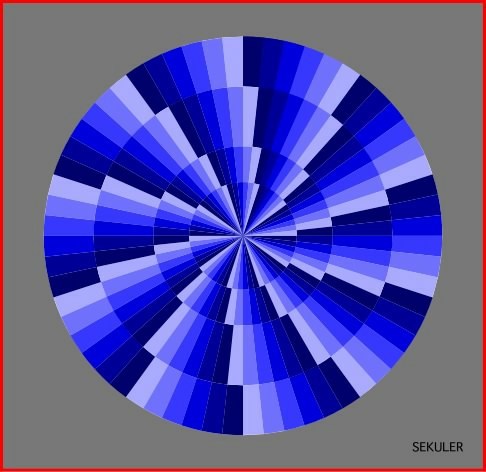
This disk appears to rotate clockwise.
This color illusion image presented by Naor-Raz and Sekuler (2000) (shown
below) might be attributable to this type.
http://www.perceptionweb.com/perception/perc0300/sekuler.jpg <access August 26, 2012>
<with permission from Robert Sekuler>
4. Kitaoka and Ashida (2003)
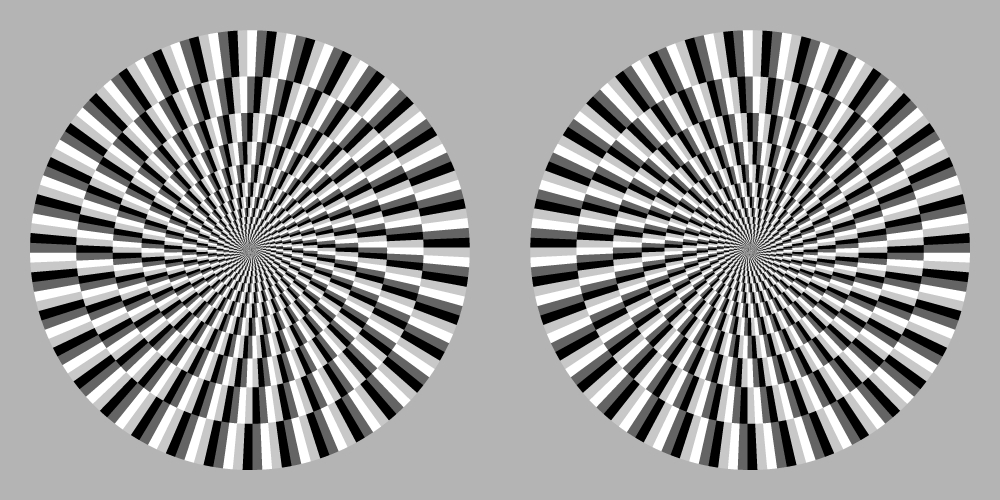
The left disk appears to rotate counterclockwise while the right one clockwise. Kitaoka and Ashida (2003) proposed that the illusory motion is strong when patterns are arranged in the following luminance order: from black, dark-gray, white, light-gray, and back to black.
References
Kitaoka, A. and Ashida, H. (2003). Phenomenal characteristics of the peripheral drift illusion. VISION (Journal of the Vision Society of Japan), 15, 261-262. PDF
5. Kitaoka (2007)
Kitaoka (2007) classified the Fraser-Wilcox illusion into Type I, IIa, IIb and III, in each of which the dark-to-light type was distinguished from the light-to-dark one.
References
Kitaoka, A. (2007) Phenomenal classification of the “optimized” Fraser-Wilcox illusion and the effect of color. Poster presentation in DemoNight, VSS2007, GWiz, Sarasota, Florida, USA, May 14, 2007.
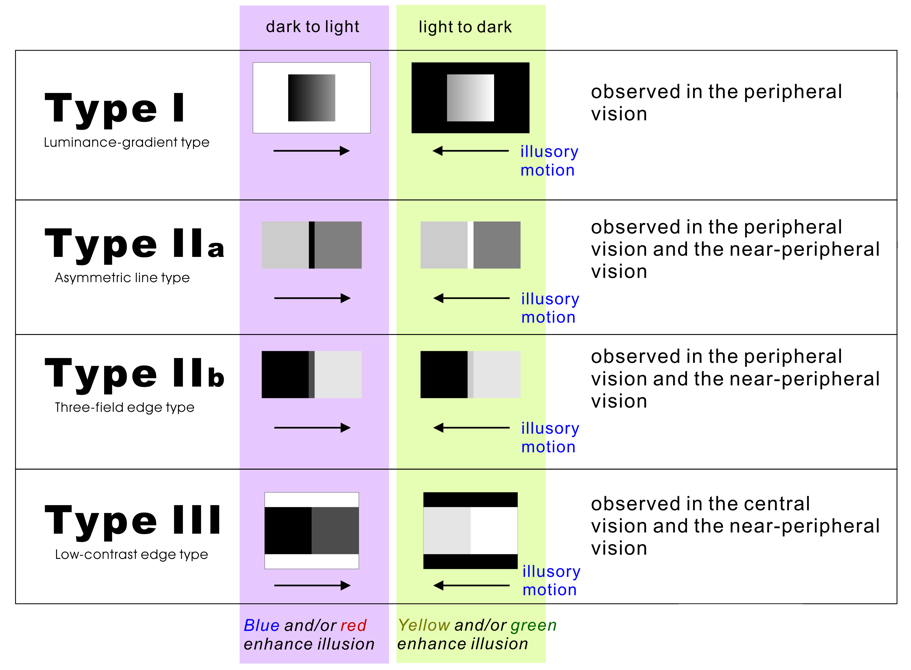
Type I
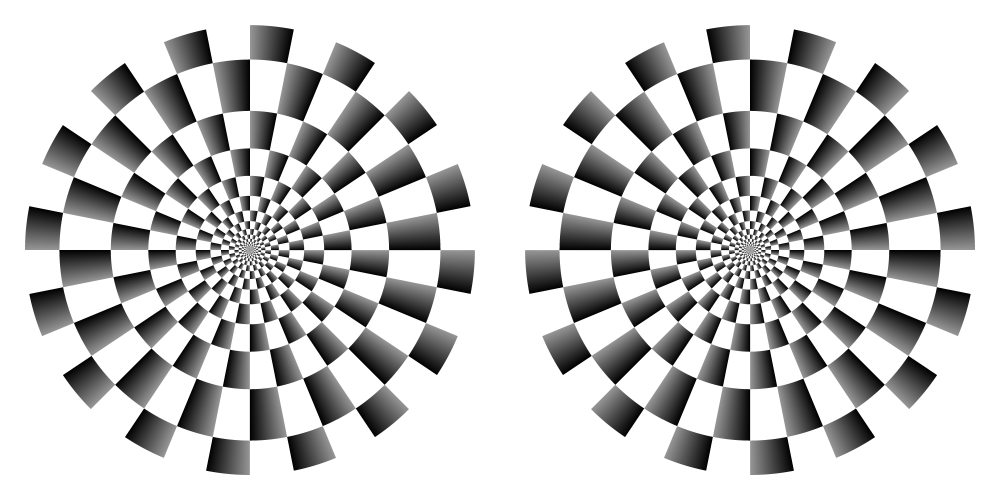
"Dark to light"
The left disk appears to rotate counterclockwise while the right one clockwise.
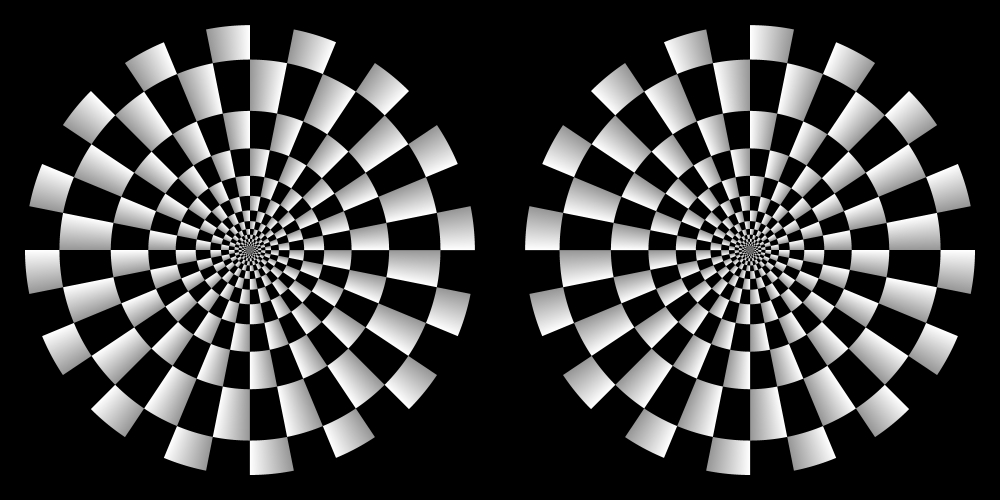
"Light to dark"
The left disk appears to rotate counterclockwise while the right one clockwise.
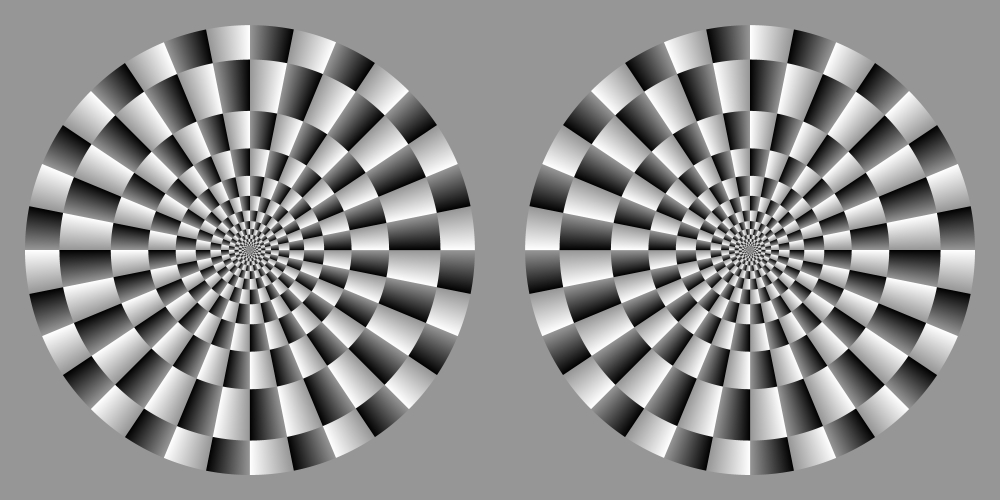
"Dark to light" and "light to dark" combined
The left disk appears to rotate counterclockwise while the right one clockwise.
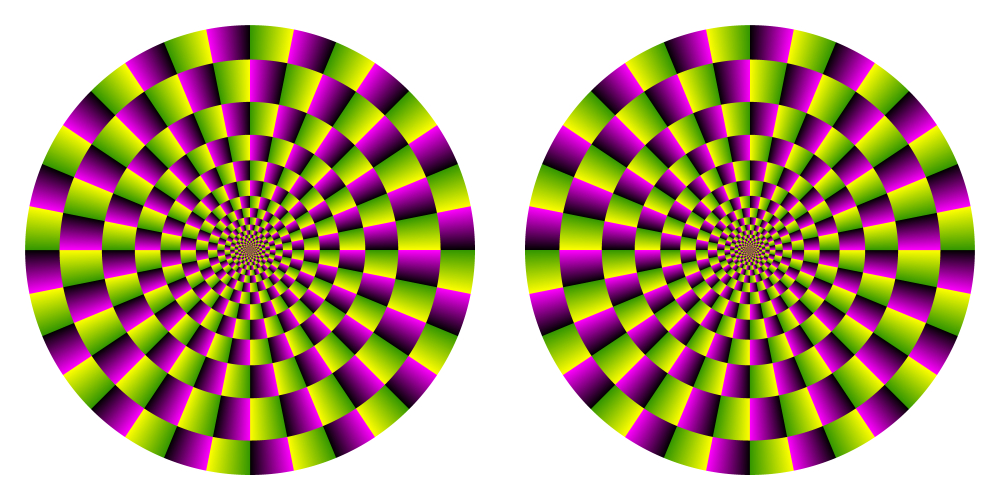
"Dark to light" and "light to dark" combined, with
color enhancement
The left disk appears to rotate counterclockwise while the right one clockwise.
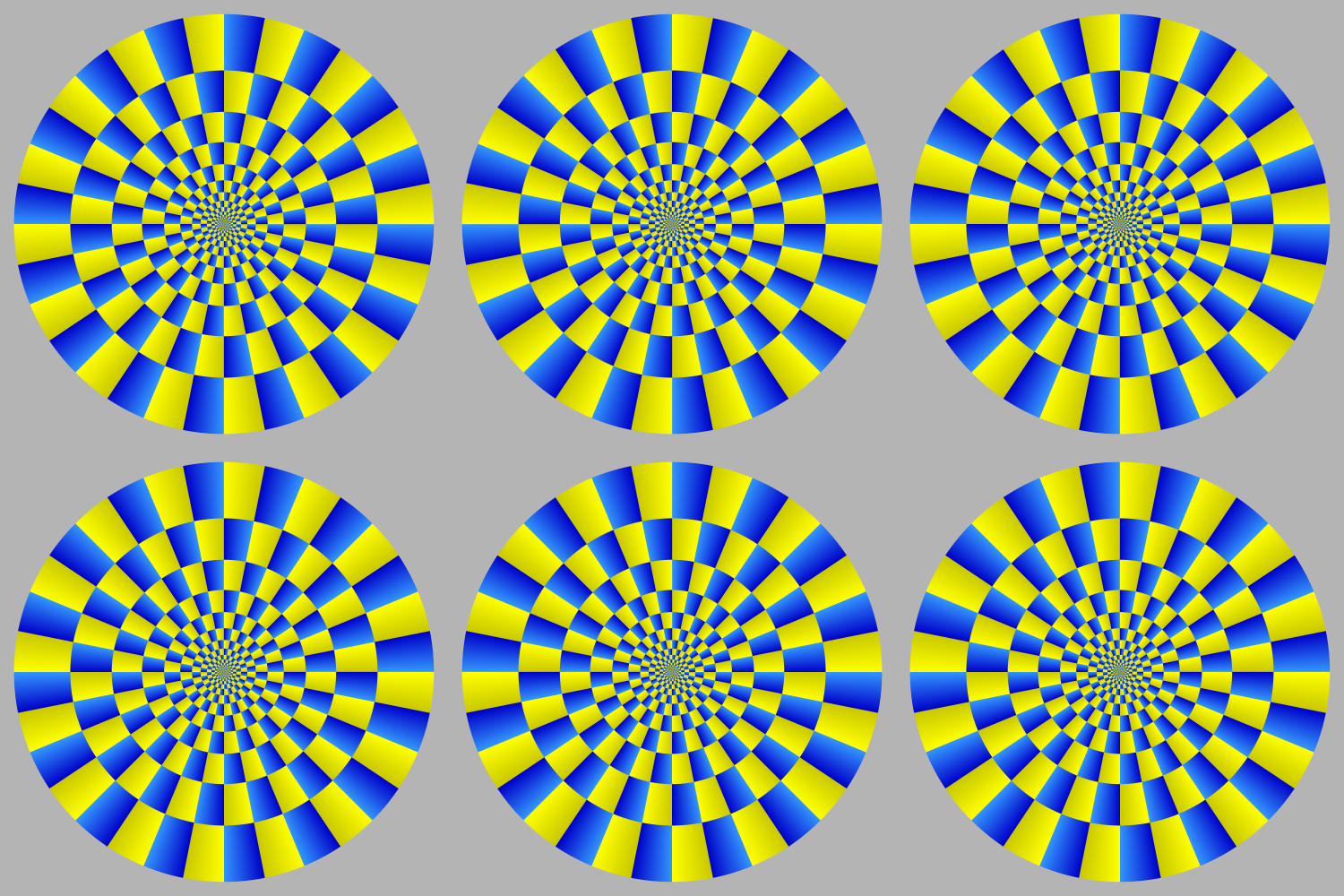
The upper-left, upper-right, and lower-middle disks appear to rotate counterclockwise
while the rest clockwise.
Type I (six disks) 1500 x 1000 (pixel)
Type I (six disks) 6000 x 4000 (pixel)
Type II
Type IIa
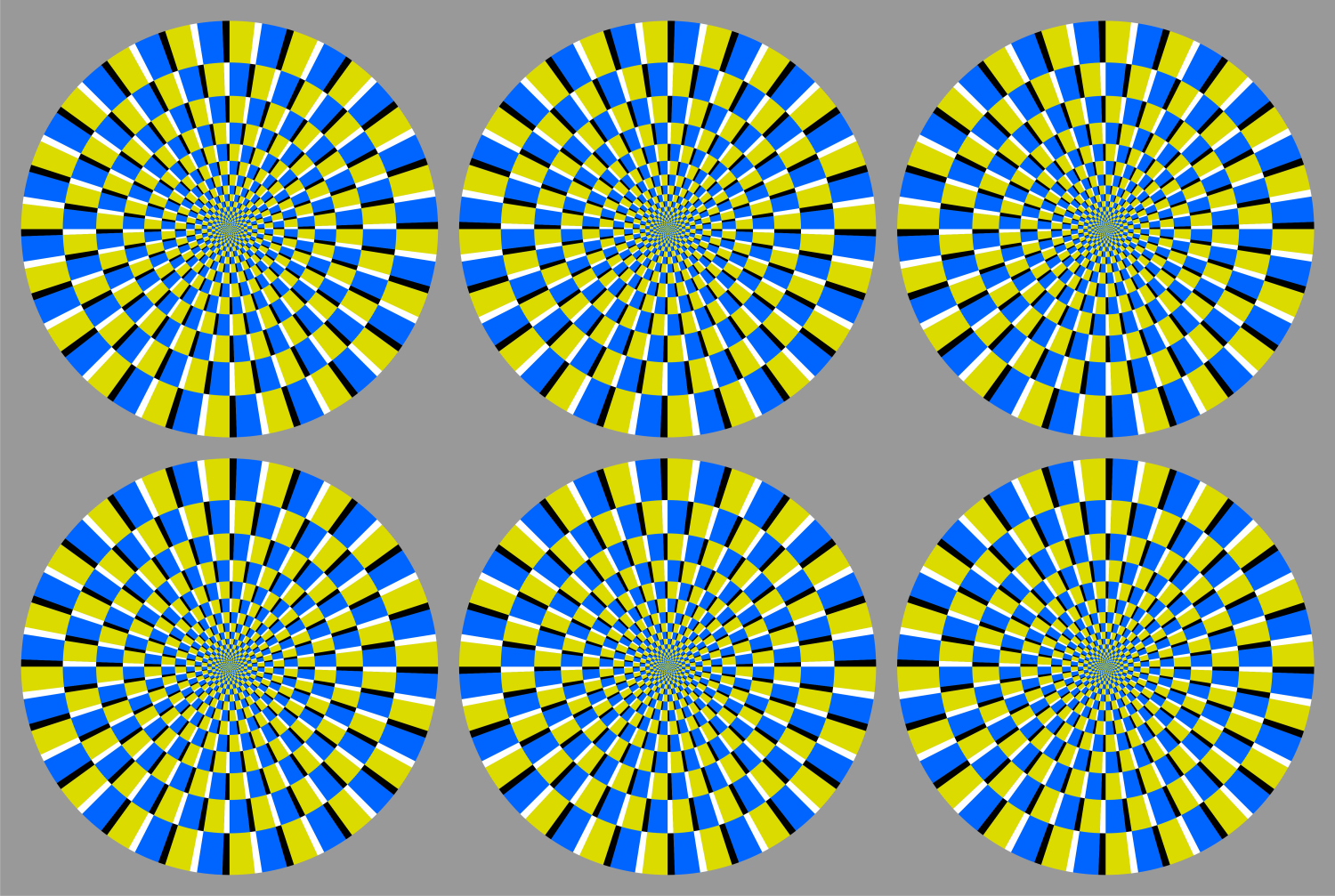
The upper-left, upper-right, and lower-middle disks appear to rotate counterclockwise
while the rest clockwise.
Type IIb
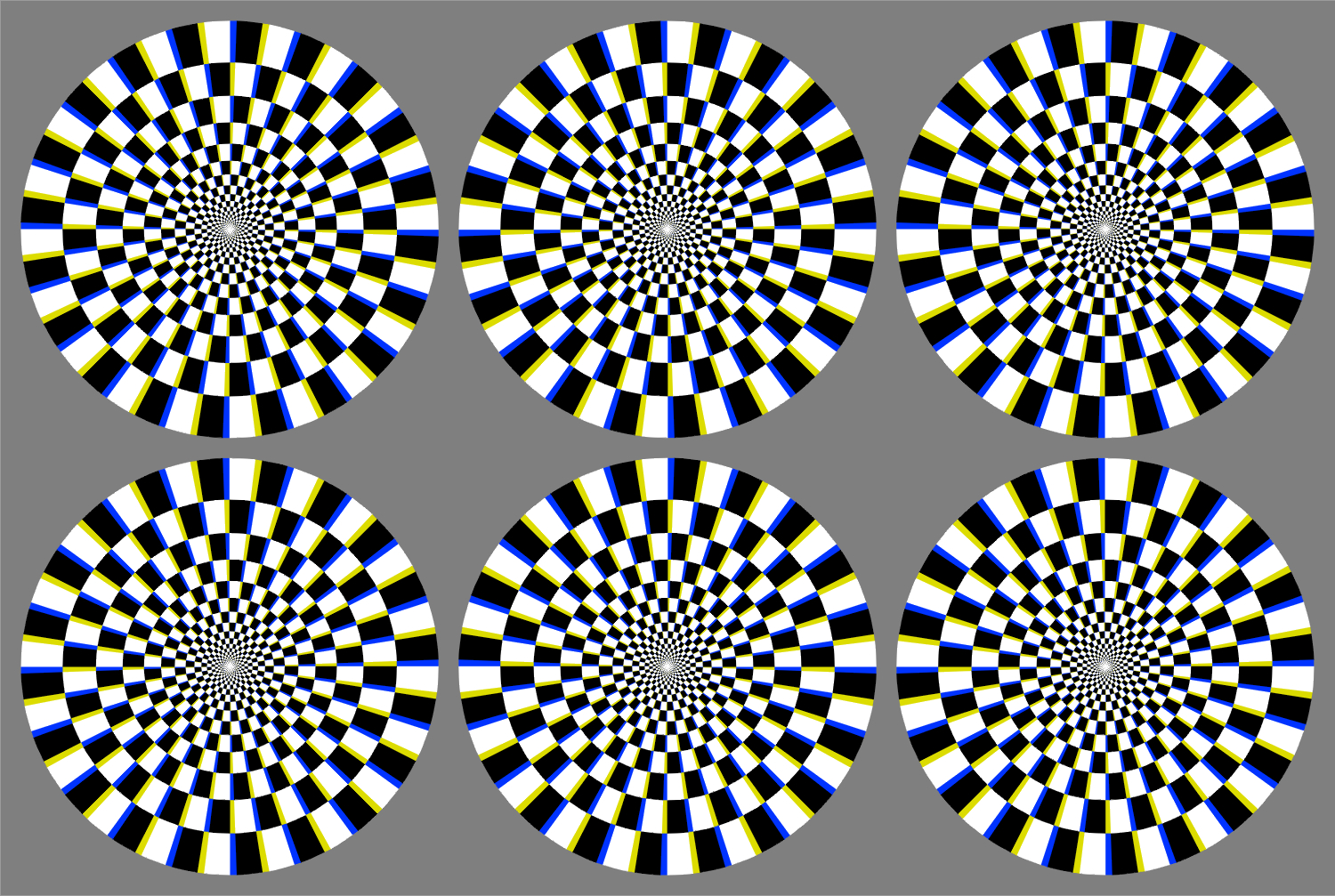
The upper-left, upper-right, and lower-middle disks appear to rotate counterclockwise while the rest clockwise.
Type IIa (six disks) 1500 x 1007 (pixel)
Type IIa (six disks) 6000 x 4031 (pixel)
Type IIb (six disks) 1500 x 1000 (pixel)
Type IIb (six disks) 6000 x 4000 (pixel)
Type III

The upper row appears to move rightward while the lower one leftward.
Type III (two rows) 1500 x 400 (pixel)
Type III (two rows) 4500 x 1200 (pixel)Type III 4500 x 1200
.jpg)
The upper-left, upper-right, and lower-middle disks appear to rotate counterclockwise
while the rest clockwise.
6. Kitaoka (2008a, b)
"Type IV" was added to the list.
References
Kitaoka, A. (2008a). Optimized Fraser-Wilcox illusions: a pictorial classification by Akiyoshi Kitaoka. Talk in Workshop No.005 "Experimental studies of anomalous motion illusions" in the 72nd Annual Convention of the Japanese Psychological Association, Hokkaido University, Sapporo, Japan, September 19, 2008. Talk
Kitaoka, A. (2008b). A new type of the optimized Fraser-Wilcox illusion in a 3D-like 2D image with highlight or shade. Journal of Three Dimensional Images (Japan), 22(4), 31-32. PDF PDF (manuscript) Presentation
Type IV
m.jpg)
The upper-left, upper-right, and lower-middle rings appear to rotate counterclockwise
while the rest clockwise.
| Type | dark to light | light to dark | Examples |
| IV new! |
 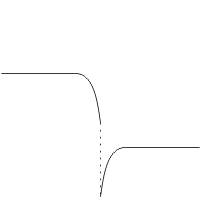 |
 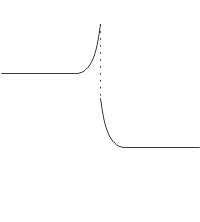 |
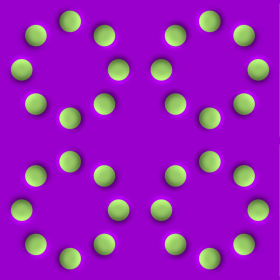 |
7. Kitaoka (2010, 2012a, b)
"Type V" was added to the list.

Black » dark-gray » white » light-gray » black
Purple » light purple » light red-purple » red »
purple
References
Kitaoka, A. (2010). Introduction to visual illusion. Tokyo: Asakura-shoten (in Japanese). Book
Kitaoka, A. (2012a). Designs using the red Fraser-Wilcox illusion. Journal
of the Color Science Association of Japan, 36, Supplement, 188-189. PDF (color manuscript) Talk
Kitaoka, A. (2012b) The Fraser-Wilcox illusion and its extension. Perception 41 ECVP Abstract Supplement, page 91 (Poster September 3, 2012). Poster PDF

"Rotating red
disks"
Each disk appears to rotate clockwise when this image is presented on a bright PC display or on a print with a bright environment.
Copyright Akiyoshi Kitaoka 2013 (January 17)
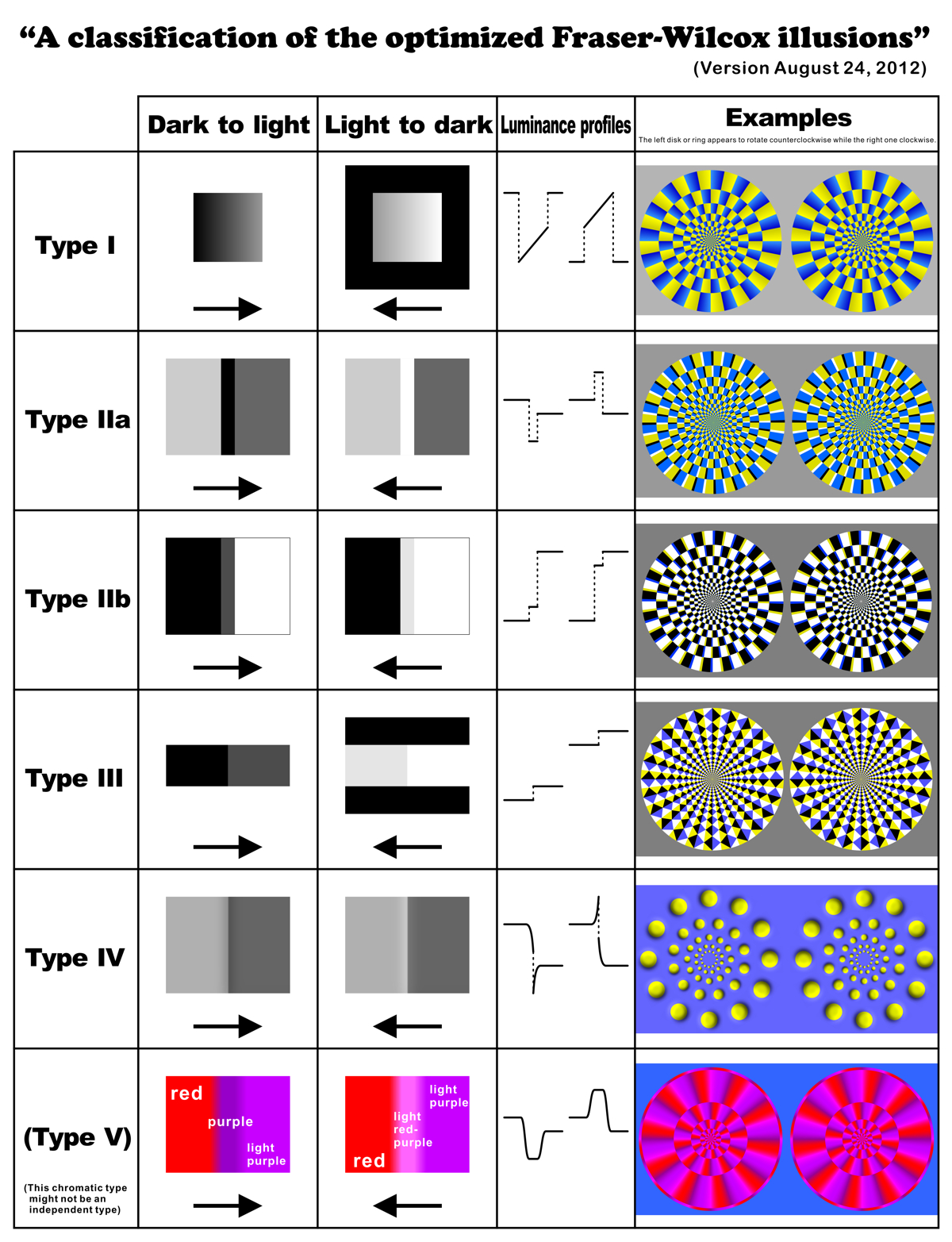
8. Yanaka and Hirano (2011)
Yanaka and Hilano (2011) reported that the Type V illusion is enhanced by mechanical shaking.
Each disk appears to rotate counterclockwise.
(Note that this movie is not their original)
References
Yanaka, K. and Hilano, T. (2011). Mechanical shaking system to enhance
"Optimized Fraser–Wilcox Illusion Type V". Perception, 40, ECVP
Abstract Supplement, page 171.
9. Yanaka (2012)
Yanaka (2012) reported that the Type V illusion is enhanced by viewing images under dark illumination.
(Note that this movie is not his original)
References
Yanaka, K. (2012). Enhancement of the optimized Fraser-Wilcox illusion Type V by swinging the image. Talk in the 5th Illusion Workshop, Meiji University, Tokyo, Japan, September 18, 2012.
10. Kitaoka (2013)
Kitaoka (2013) reported that the direction of illusory motion of the Type V illusion in a printed image is reversed under dark illumination.
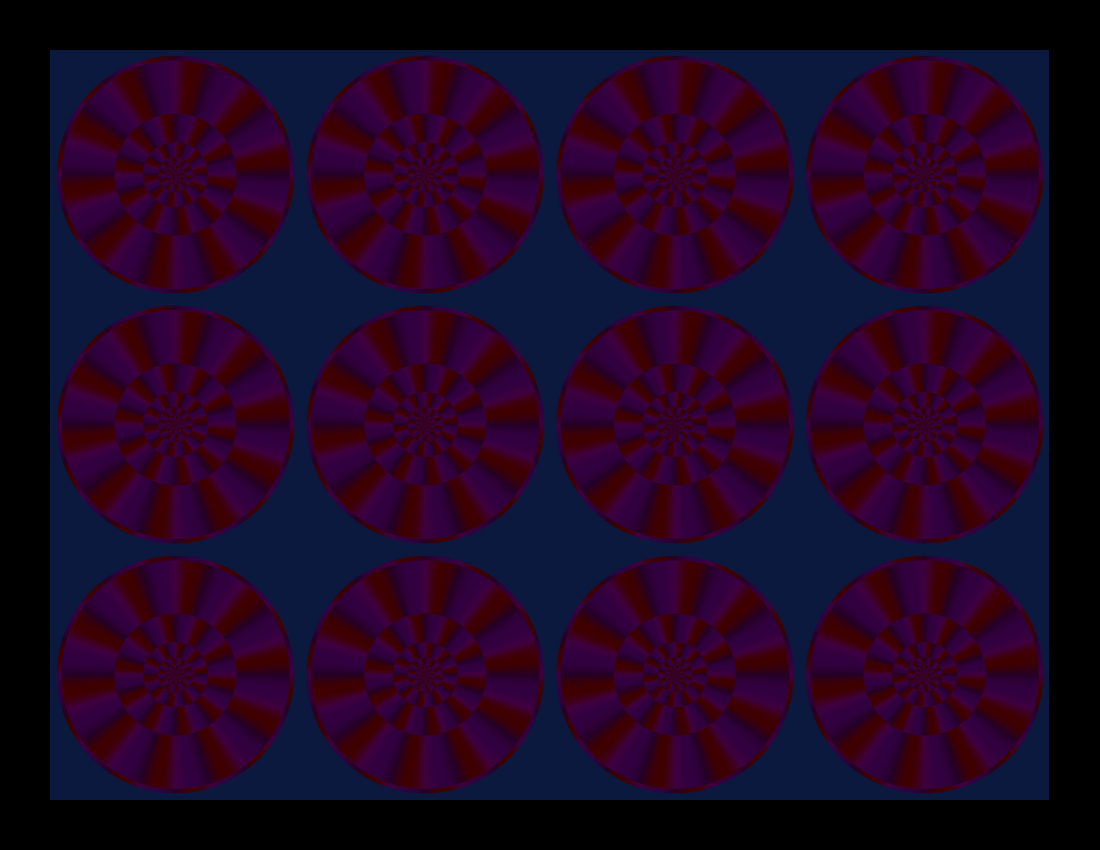
Each disk appears to rotate counterclockwise in a printed image. PC displays
or projector-projected images show weak effects.
References
Kitaoka, A. (2013). Invisible color and visible color: Mystery of color the brain feels. Talk in the Shizuoka Science Museum Ru-Ku-Ru, Shizuoka, Japan, January 13, 2013. Talk
The present study
explores this dimorphism comparing to related phenomena.
Flickering presentation of a particular order makes observers see illusory motion of two different directions.
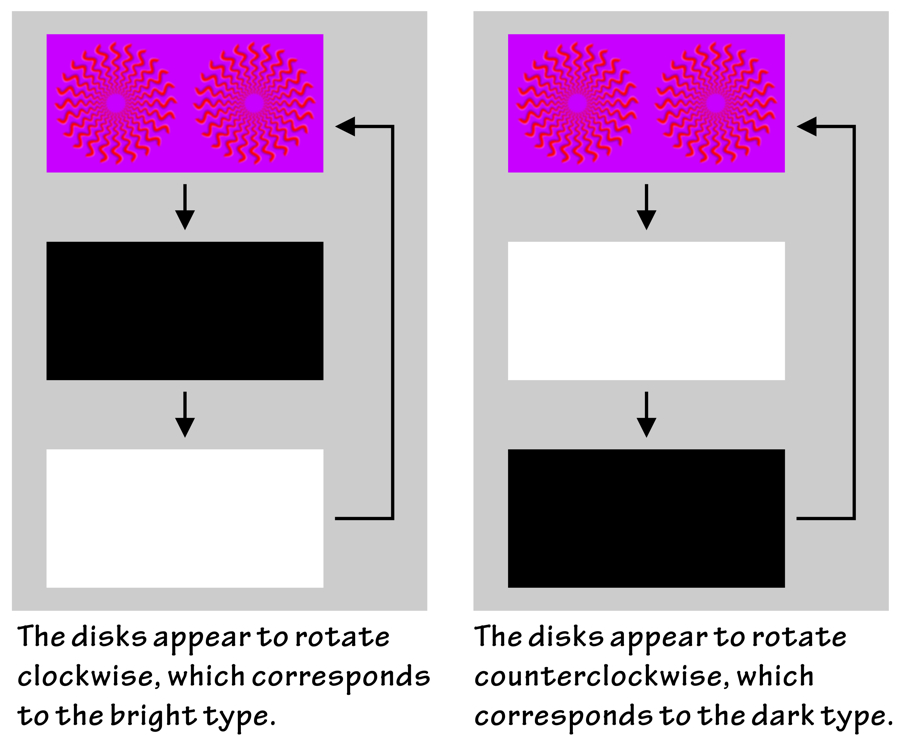
Warning: The movies shown below include flickering patterns. Please do not keep
watching them for a long time. Never copy them.
Target » black » white » target
Target » white » black » target
Cf. Flickering presentation of a Fraser-Wilcox figure also makes observers see illusory motion of two different directions.
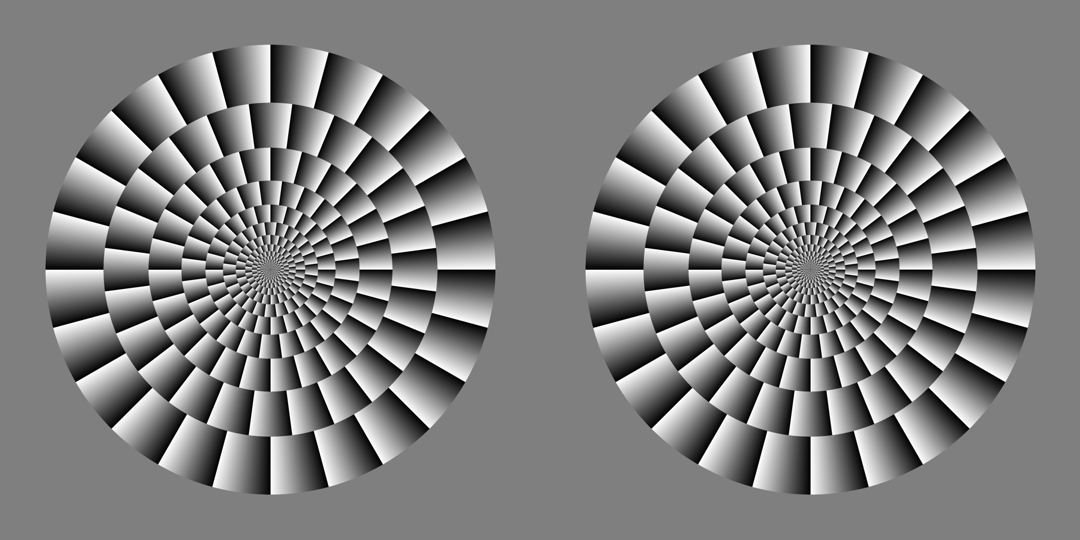
A Fraser-Wilcox figure, which makes some obersvers see clockwise rotation
while makes others see counterclockwise rotation.
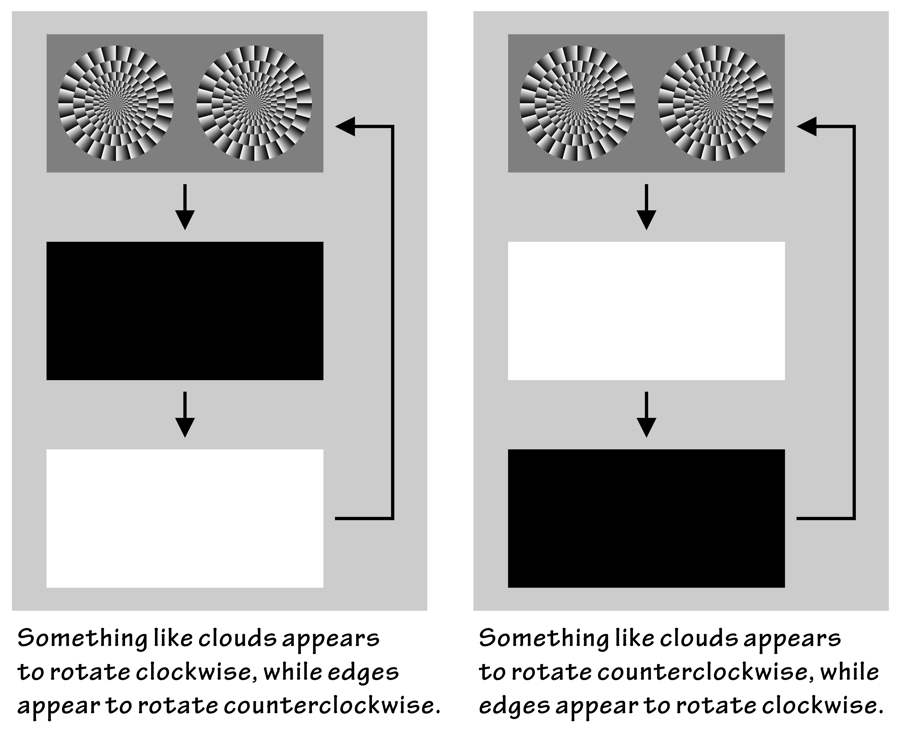
Warning: The movies shown below include flickering patterns. Please do not keep
watching them for a long time. Never copy them.
Target » black » white » target
Target » white » black » target
It is suggested that these dimorphisms might have something to do with
the subjective color phenomena such as the Behnham top because of the same
temporal arrangement of stimuli.
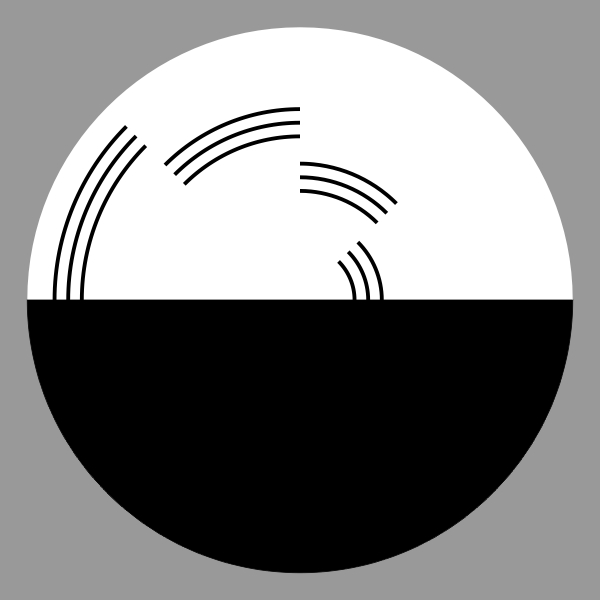
Conclusion: These observations might lead to clarification of motion perception, color mechanism, as well as the role of color in motion perception in the future.

Please correct the distributed handout shown below.
correct: "Kogakuin University"
mistake: "Kokugakuin University"
